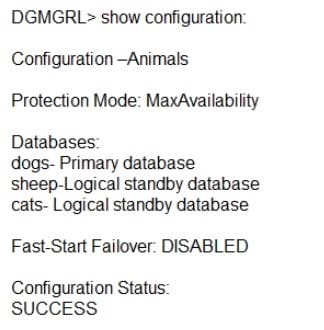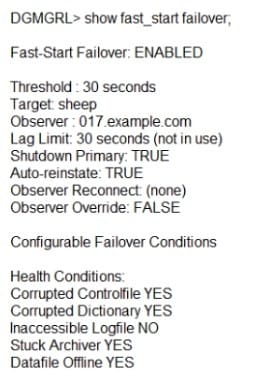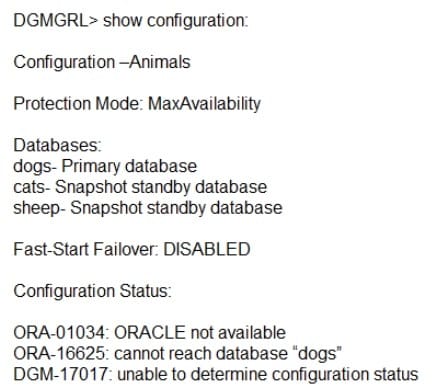Exam Details
Exam Code
:1Z0-066Exam Name
:Oracle Database 12c: Data Guard AdministratorCertification
:Oracle CertificationsVendor
:OracleTotal Questions
:204 Q&AsLast Updated
:Mar 26, 2025
Oracle Oracle Certifications 1Z0-066 Questions & Answers
-
Question 21:
Your expertise is requested for these customer requirements:
1. The Data Guard environment must be in maximum protection mode. 2 Reports must be offloaded to a physical standby database.
3.
There must be no lag between the primary and standby databases that affect the reports produced.
4.
The primary database must be resilient in case of a single network failure.
Which solution is correct for these requirements?
A. two standby databases, at least one of them a physical standby with Real-Time Query enabled and the STANDBY_MAX_DELAY parameter set to zero, receiving redo from the primary with asynchronous transport
B. two standby databases, at least one of them a physical standby with Real-Time Query enabled and the STANDBY_MAX_DATA_DELAY parameter set to zero, receiving redo from the primary with synchronous transport
C. one physical standby database with Real-Time Query enabled, receiving redo from two Far Sync instances that are connected the primary
D. one physical standby database with Real-Time Query enabled and the STANDBY_MAX_DATA_DELAY parameter set to zero, receiving redo from the primary with synchronous transport
E. two physical standby databases with Real-Time Query enabled, receiving redo from the primary with the LOG_ARCHIVE_DEST_n attnbutes SYNC NOAFFIRM to minimize the performance impact on the primary.
-
Question 22:
You are required to change the Data Guard Configuration protection mode from MAXPERFORMANCE to MAXAVAJLABILITY using Enterprise Manager Cloud Control Which two are true about this change?
A. If the primary database cannot write its redo to at least one synchronized standby database, then the protection level remains unchanged.
B. The primary database instance will remain up and running, if it cannot write redo to at least one synchronized standby database.
C. Transactions will not commit until all redo data needed to recover those transactions are written to the online redo log, and to the standby redo log on at least one synchronizes standby database.
D. Fast start failover can be enabled when making the chance.
E. Real time apply will be automatically turned on.
-
Question 23:
You must configure an Oracle Data Guard environment consisting of:
1. A primary database
2 One Physical Standby Database
3. One Logical Standby Database
You must meet these requirements:
1.
Primary database availability should not be compromised by the availability of the standby databases.
2.
Under normal operations, transactions executed on the primary database should not commit before redo is written to disk on both the primary database and at least one standby database.
Which redo transport mode and which protection mode would you configure to meet these requirements?
A. SYNC AFFIRM and Maximum Protection
B. SYNC NOAFFIRM and Maximum Protection
C. SYNC AFFIRM and Maximum Availability
D. SYNC NOAFFIRM and Maximum Availability
E. ASYNC and Maximum Performance
-
Question 24:
Which three statements are true about standby redo logs in a Data Guard configuration with no Oracle Streams or Goldengate configured?
A. They are required on a logical standby for real-time apply
B. They are required only for synchronous redo transport.
C. Only standby databases can write redo to them.
D. It is recommended to have them on the primary database.
E. They are required on a physical standby for real-time apply.
F. The LGWR process writes to them on a standby database.
-
Question 25:
Examine the Data Guard configuration:

Which three will be true after a switchover to Sheep?
A. Cats will be an enabled logical standby database
B. Cats will be a disabled logical standby database.
C. Dogs will be a logical standby database.
D. Dogs will be a physical standby database
E. Sheep will be the primary database.
-
Question 26:
Examine the Fast-start configuration

Oracle Error Conditions: (none) Which three are true?
A. The observer will initiate a failover when the primary database is unable to produce local archived redo log files.
B. An automatic failover will be initiated even if the target standby database lags behind the primary
C. The observer is running
D. a failover may occur if the observer has lost connectivity to the primary database, even if the Fast-Start Failover target standby database has a good connection to the primary database
E. The configuration operates in Maximum Availability mode
F. The configuration operates in Maximum Performance mode
-
Question 27:
Which three are benefits of using the Data Guard Broker to manage standby databases?
A. it simplifies physical standby database creation
B. It provides an easy failover capability using a single command.
C. it coordinates database state transitions and updates database properties dynamically.
D. it automatically changes database properties after the protection mode for a configuration is changed
E. It provides an easy switchover capability using a single command.
F. It simplifies logical standby database creation.
-
Question 28:
Examine the Data Guard configuration:

Which three will be true after a successful failover to Cats?
A. Sheep will be in the disabled state.
B. Sheep will be in the enabled state.
C. Dogs will be in the disabled state and has to be manually reinstated
D. The configuration will be in Maximum Performance mode.
E. The configuration will be in Maximum Availability mode.
-
Question 29:
Which two Data Guard monitoring activities may be performed using Enterprise Manager Cloud Control?
A. monitoring the redo apply rate on a physical standby
B. monitoring the redo apply rate on a logical standby
C. monitoring the undo generation rate on a logical standby
D. monitoring the redo apply rate on a snapshot standby
E. monitoring the transport lag
F. monitoring the undo generation rate on the primary
-
Question 30:
Which three statements are true about Global Sequences when connected to a physical standby database with Real-Time Query enabled?
A. if the CACHE option is set then the size of the cache must be at least 100
B. Their creation requires that a LOG_ARCHIVE_DEST_n parameter be defined in the standby that points back to their primary
C. Their usage will always have a performance impact on the primary database.
D. Their usage may have a performance impact on the physical standby database if the CACHE size is too small
E. They must have the NOORDER and CACHE options set.
Related Exams:
1Z0-020
Oracle8i: New Features for Administrators1Z0-023
Architecture and Administration1Z0-024
Performance Tuning1Z0-025
Backup and Recovery1Z0-026
Network Administration1Z0-034
Upgrade Oracle9i/10g OCA to Oracle Database OCP1Z0-036
Managing Oracle9i on Linux1Z0-041
Oracle Database 10g: DBA Assessment1Z0-052
Oracle Database 11g: Administration Workshop I1Z0-053
Oracle Database 11g: Administration II
Tips on How to Prepare for the Exams
Nowadays, the certification exams become more and more important and required by more and more enterprises when applying for a job. But how to prepare for the exam effectively? How to prepare for the exam in a short time with less efforts? How to get a ideal result and how to find the most reliable resources? Here on Vcedump.com, you will find all the answers. Vcedump.com provide not only Oracle exam questions, answers and explanations but also complete assistance on your exam preparation and certification application. If you are confused on your 1Z0-066 exam preparations and Oracle certification application, do not hesitate to visit our Vcedump.com to find your solutions here.